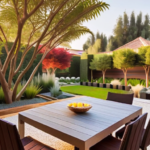Florida is known for its delicious seafood, beautiful beaches, warm weather, and palm trees. Many palm trees are native to Florida, and the state’s tropical climate makes it an excellent place to grow palm trees. Palm trees make wonderful landscaping plants.
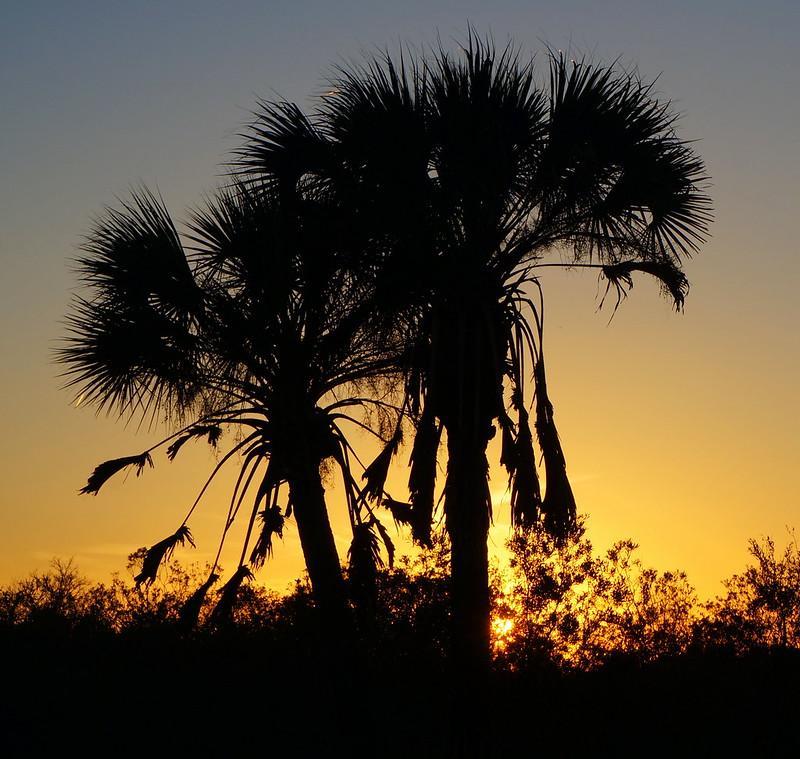
Sabal palmetto is an elegant evergreen palm with a full, round canopy of fan-shaped leaves.
Not only are they beautiful to look at, but they are also practical and make excellent privacy screens. However, with so many types around, which ones should you plant?
Florida is home to about 50 unique species of palm trees. They exist in various leaf colors, sizes, shapes, and heights. And as you travel south in Florida, palm trees become more and more tropical. Choosing the best palm tree for your landscape will depend on the look you are going for and which habitable zone you live in.
But how to start looking? How about a list of best Palm Trees in Florida and the most popular Florida Palm Tree Species? So, without further ado, let’s get started!
Best Types Of Palm Trees In Florida
There are dozens of palm tree species in Florida with varying heights and other characteristics such as leaf color, size, shape, and texture. Some, such as the giant palm trees, can reach 100 feet or more, while other dwarf types rarely grow taller than 3 feet.
Nevertheless, here are the most common palm trees in Florida, i.e., Sunshine State, described along with their main features and identifications guide.
1. Blue Latan Palm (Latania Loddigesii)
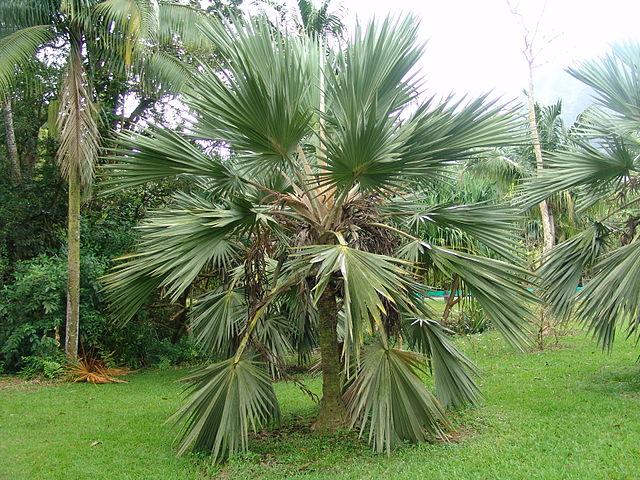
The slow-growing Blue Latan Palm is an adamant, adaptable, and one of the best ornamental fan palms.
Key Characteristics
| Other Common Names | Blue Latan, Blue Latania, Latanier Bleu |
| USDA Hardiness Zones | 10b – 11 |
| Geographical Origin | Round Island, Mauritius |
| Mature Height | 20-30 feet (6-9 meters) |
| Mature Spread | 10-15 feet (3-4.5 meters) |
| Life Span | 100-200 years |
| Foliage & Floral Features | Fan-shaped blue-green leaves. Creamy flowers in summer. |
Description & Identification Guide
If you are trying to identify the Blue Latan Palm, look for a tree with a slender gray stem with bluish-green fan-shaped leaves forming a dense crown on the top. It can be planted in groups along the driveways or grown individually in the garden as a specimen plant.
Nevertheless, this plant will draw attention no matter where it’s put. And, aside from its looks, it has separate sexes, with male and female flowers growing on different plants.
2. Yellow Latan Palm (Latania Verschaffeltii)
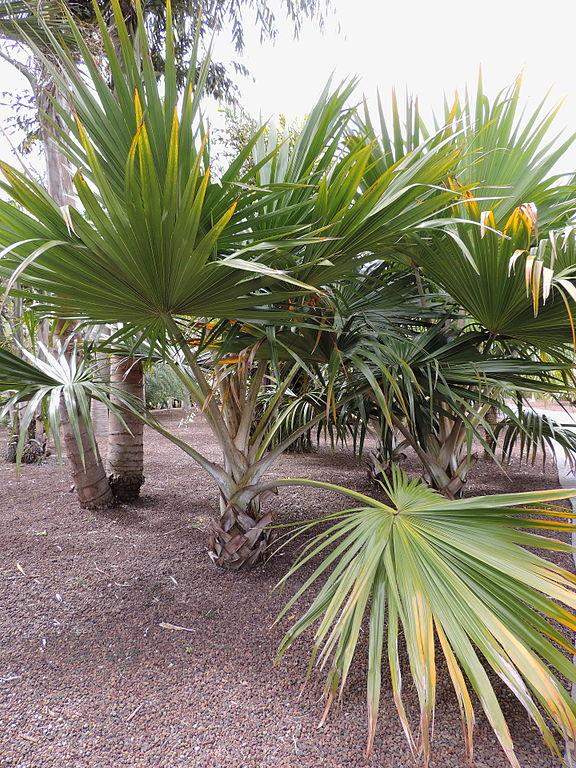
Looking for an easy-to-grow, no-fuss palm that grows in warmer climates, look no further!
Key Characteristics
| Other Common Names | Yellow Latan, Verschaffelt’s Latania, Latanier Jaune |
| USDA Hardiness Zones | 10a to 11b |
| Geographical Origin | Mascarene Islands |
| Mature Height | 20-40 ft (6-12 m) |
| Mature Spread | 10-15 ft (3-4.5 m) |
| Life Span | Up to 80 years |
| Foliage & Floral Features | Fan-shaped fronds with yellow margins. Small, inconspicuous flowers. |
Description & Identification Guide
If you are looking at a palm with striking yellow-green color fronds (leaves), forming a symmetrical, round crown at the top of the tree and a tout grayish-brown trunk that is slightly swollen at the base, chances are you are seeing a Yellow Latan Palm Tree.
And similar to the Blue Latan Palm, the Yellow Latan Palm is dioecious, meaning it has male and female flowers growing on separate trees. You can also plant it individually as a standalone specimen or place it in groupings to create a natural barrier.
3. Caribbean Royal Palm (Roystonea Oleracea)

The Caribbean Royal palm is a tall and widely grown ornamental and street tree in tropical areas.
Key Characteristics
| Other Common Names | Royal Palm, Cuban Royal Palm, Palma Real |
| USDA Hardiness Zones | 10b to 11 |
| Geographical Origin | The Caribbean region, Central and South America |
| Mature Height | 50-70 ft (15-21 m) |
| Mature Spread | 15-25 ft (4.5-7.5 m) |
| Life Span | Up to 80 years |
| Foliage & Floral Features | Pinnate fronds with glossy green color. Cream-colored flowers in large clusters. |
Description & Identification Guide
The Caribbean Royal Palm has feather-shaped leaves that form a lush, green canopy at the top of the tree. The stem is slender, smooth, and gray and gradually narrows towards the top. Furthermore, the palm leaflets are arranged in a slightly V-shaped pattern.
A great feature of this palm tree is that it is self-cleaning. The dead fronds from the plant fall off on their own, which minimizes maintenance. Overall, the Caribbean Royal Palm is an iconic symbol of tropical landscapes and a popular choice for landscaping.
4. Proctor’s Silver Palm (Coccothrinax Proctorii)
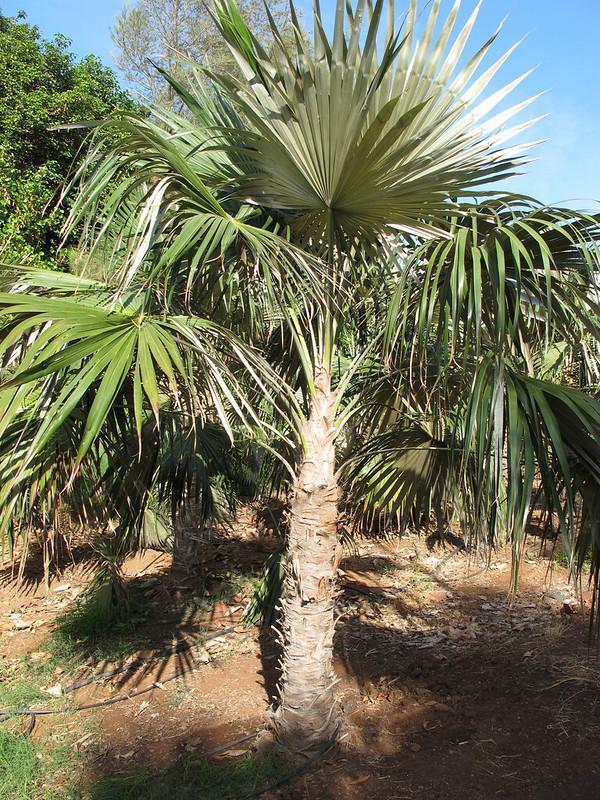
Proctor’s Silver Palm is considered Endangered by the IUCN, with only 400K specimens left.
Key Characteristics
| Other Common Names | Cayman thatch palm |
| USDA Hardiness Zones | 10a to 11 |
| Geographical Origin | Puerto Rico |
| Mature Height | 10-20 ft (3-6 m) |
| Mature Spread | 6-10 ft (1.8-3 m) |
| Life Span | Up to 80 years |
| Foliage & Floral Features | Silvery-gray fan-shaped leaves. Small creamy white flowers followed by purple-black fruits. |
Description & Identification Guide
Proctor’s Silver Palm has fan-shaped leaves with the leaves’ upper side being green and having a slight sheen to them, whereas there is a distinctive silver-gray color on the underside of the leaves. The palm tree is often used as a landscaping tree in compact spaces because of its small size and unique foliage. One of the great features of this palm is its attractive fruits which are small and red and often grow in large clusters.
RELATED: Top 10 Types of Elm Trees| Elm Tree Uses, Pictures and Identification Guide
5. Mexican Fan Palm (Washingtonia Robusta)

Fast-growing and tolerant Mexican Fan Palm delivers a tropical look to your garden in no time.
Key Characteristics
| Other Common Names | Skyduster, Petticoat Palm |
| USDA Hardiness Zones | 9a to 11 |
| Geographical Origin | Northern Mexico, Baja California |
| Mature Height | 50-80 ft (15-24 m) |
| Mature Spread | 10-15 ft (3-4.5 m) |
| Life Span | Up to 100 years |
| Foliage & Floral Features | Large, fan-shaped leaves. Cream-colored flowers in clusters. |
Description & Identification Guide
Mexican Fan Palm is a low-maintenance palm that adds an eye-catching beauty to any landscape and fills the whole space with its tremendous height. Aside from its size, its main feature is its dark green leaves with deep cuts that give them a distinct “V” shape.
Furthermore, Mexican Fan Palm can tolerate a wide range of soils and climatic conditions, and it is often planted in urban landscapes, along roadsides, and in parks and gardens.
6. Alexandra Palm (Archontophoenix Alexandrae)
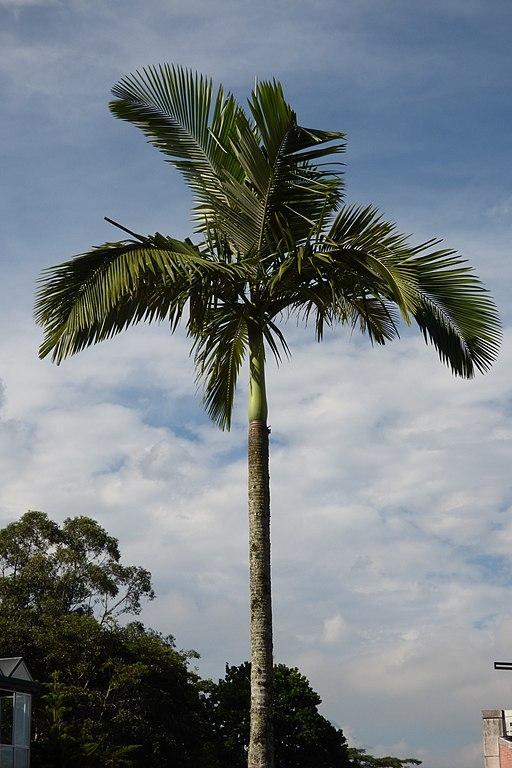
Alexandra’s palm is a solitary, fast-growing palm with large leaves, exuding an elegant appearance.
Key Characteristics
| Other Common Names | King Palm |
| USDA Hardiness Zones | 10b to 11 |
| Geographical Origin | Australia |
| Mature Height | 40-60 ft (12-18 m) |
| Mature Spread | 10-15 ft (3-4.5 m) |
| Life Span | Up to 80 years |
| Foliage & Floral Features | Pinnate fronds with glossy green color. Cream-colored flowers followed by bright red fruits. |
Description & Identification Guide
Because of its rapid growth, the Alexander Palm is perfect for gardeners who want to establish a native tropical garden quickly. Its leaves are pinnate and dark green, with leaflets arranged along the leaf’s length. In contrast, the stem is smooth, gray, and slender.
Overall, Alexander Palm is easy to grow and care for, and its fronds provide a good amount of shade, making it ideal for big gardens, parks, and urban landscapes.
7. Christmas Palm (Adonidia Merrillii)
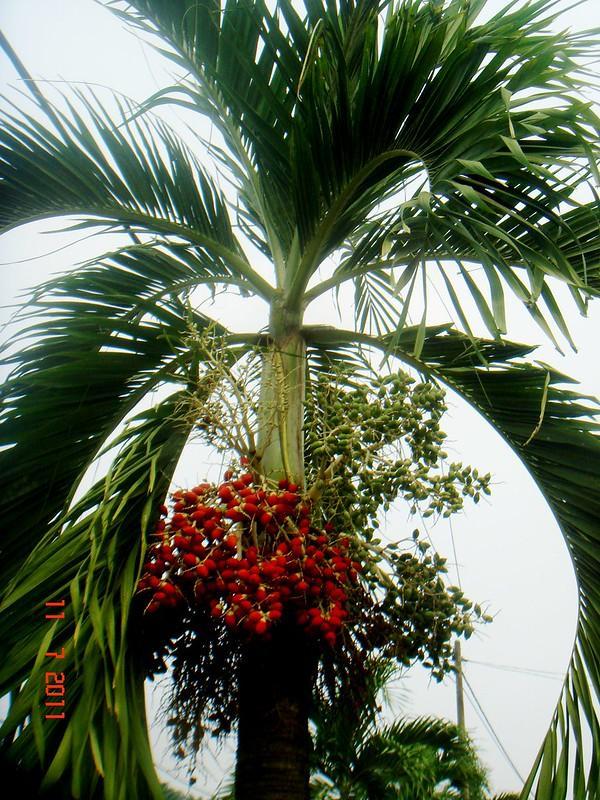
Christmas Palm is a highly ornamental palm that works stunningly in tiny landscape areas.
Key Characteristics
| Other Common Names | Manila Palm, Dwarf Royal Palm |
| USDA Hardiness Zones | 10b to 11 |
| Geographical Origin | Philippines |
| Mature Height | 20-25 ft (6-7.5 m) |
| Mature Spread | 6-10 ft (1.8-3 m) |
| Life Span | Up to 50 years |
| Foliage & Floral Features | Pinnate fronds with a dark green color. White flowers that turn into red fruits resembling Christmas ornaments. |
Description & Identification Guide
Christmas Palm is an average-sized tree with a slender, smooth, gray trunk and pinnate leaves with a bright green color. It is widely used in landscaping in tropical and subtropical regions because of its low-maintenance nature and unique look.
The palm gets its name from bright red fruit that can be seen hanging from the tree during the winter months and resembles small Christmas ornaments.
8. Golden Cane Palm (Dypsis Lutescens)
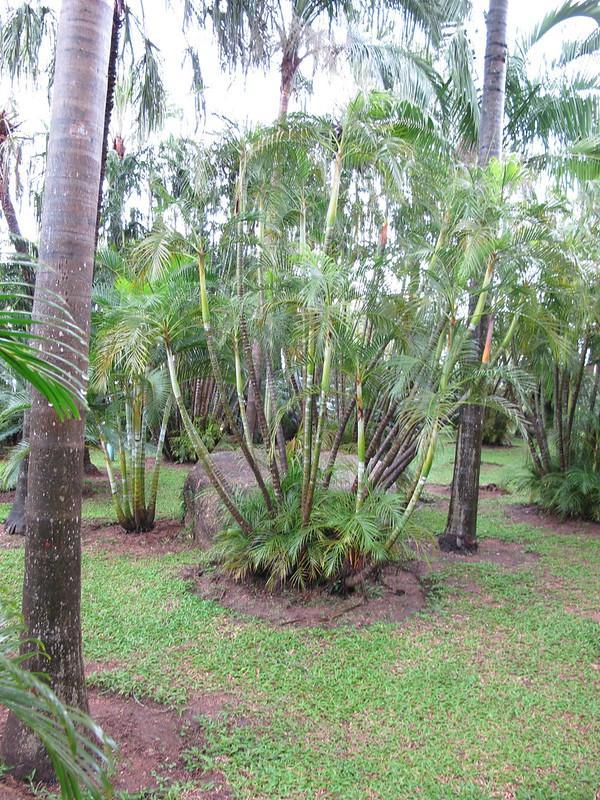
Lush and air purifying, the Golden Cane Palm is suitable for growing both indoors and outdoors.
Key Characteristics
| Other Common Names | Areca Palm, Yellow Palm |
| USDA Hardiness Zones | 10b to 11 |
| Geographical Origin | Madagascar, Southeast Asia |
| Mature Height | 20-30 ft (6-9 m) |
| Mature Spread | 10-15 ft (3-4.5 m) |
| Life Span | Up to 50 years |
| Foliage & Floral Features | Pinnate fronds with a yellow-green color. Small, yellow flowers followed by small, black fruits. |
Description & Identification Guide
The Golden Cane Palm is native to Madagascar. It has multiple slender, yellowish-brown trunks and bright green leaves with leaflets arranged along the length of the leaf. It is a relatively fast-growing palm species that can quickly establish itself in various soils.
A great feature of the Golden Cane Palm is its good shade tolerance, making it excellent for homes, gardens, and landscapes that do not get access to full sunlight.
9. Lady Palm (Rhapis Excelsa)
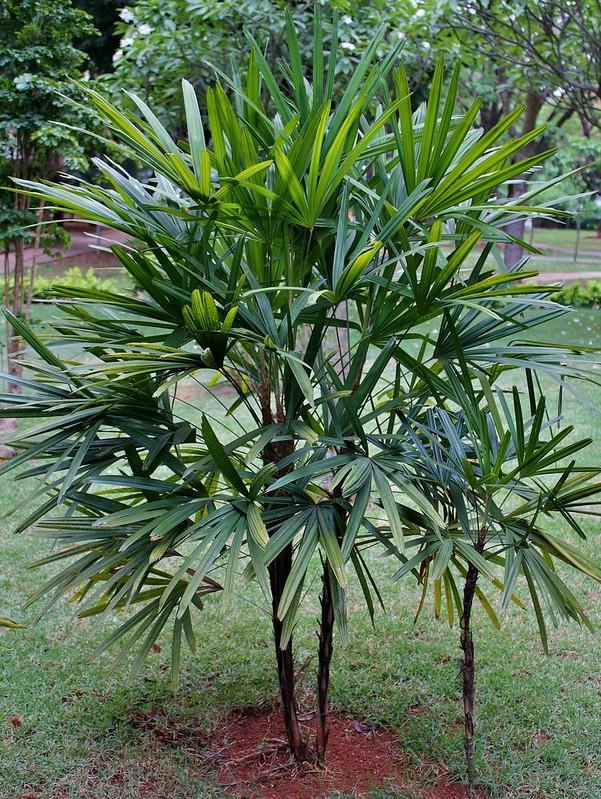
Lady Palm is an evergreen fan palm that resembles a cycad and makes an excellent indoor plant.
Key Characteristics
| Other Common Names | Broadleaf Lady Palm |
| USDA Hardiness Zones | 8b to 11 |
| Geographical Origin | China, Japan, and Taiwan |
| Mature Height | 6-12 ft (1.8-3.6 m) |
| Mature Spread | 3-5 ft (0.9-1.5 m) |
| Life Span | Up to 100 years |
| Foliage & Floral Features | Palmate fronds with a dark green color. |
Description & Identification Guide
Unlike many palm trees with tall trunks and reaching enormous heights, the lady palm is a dwarf, has a shrub-like growth, and rarely exceeds 10 feet in height. The stem’s color varies from light to dark green, and the plant is covered in glossy green, feathery leaves.
Lady Palm is a famous landscaping tree in Florida due to its adaptability to drought and salt. Also, it survives both full sun and partial shade, making it suitable for various landscapes.
10. Parlor Palm (Chamaedorea Elegans)
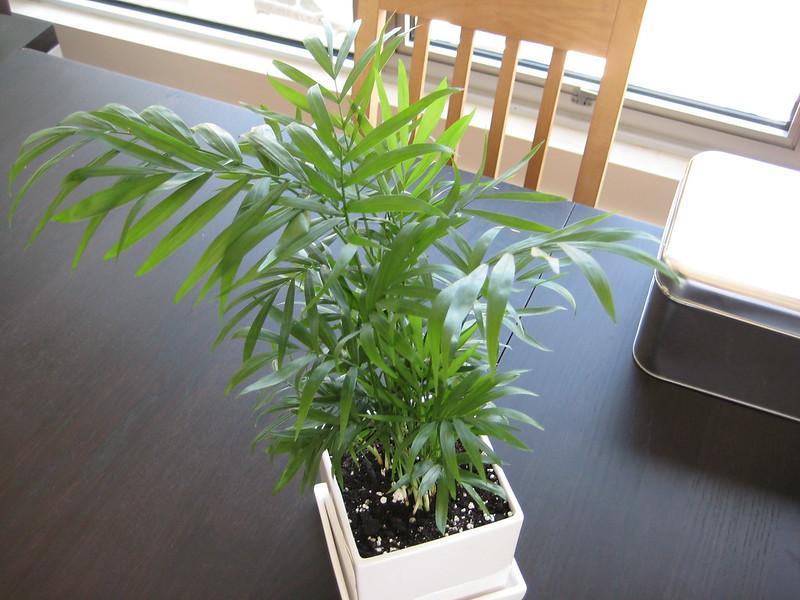
The parlor palm is a staple of a houseplant that synchronously mixes grace and utility.
Key Characteristics
| Other Common Names | Neanthe Bella Palm, Good Luck Palm |
| USDA Hardiness Zones | 10 to 11 |
| Geographical Origin | Mexico, Guatemala, and Belize |
| Mature Height | 4-6 ft (1.2-1.8 m) |
| Mature Spread | 2-3 ft (0.6-0.9 m) |
| Life Span | Up to 50 years |
| Foliage & Floral Features | Pinnate fronds with a light green color |
Description & Identification Guide
Parlor Palm is another small and shrubby palm that makes an excellent indoor plant.
Its stems are smooth and often marked with small, circular leaf scars. Furthermore, the branches become woody at the base as the plant matures. The leaves, conversely, are pinnate, meaning they have feather-like leaflets that grow in opposite pairs and are bright green.
Also, Parlor Palm is an excellent choice for palm beginners due to its low-care nature.
11. Pygmy Date Palm (Phoenix Roebelenii)
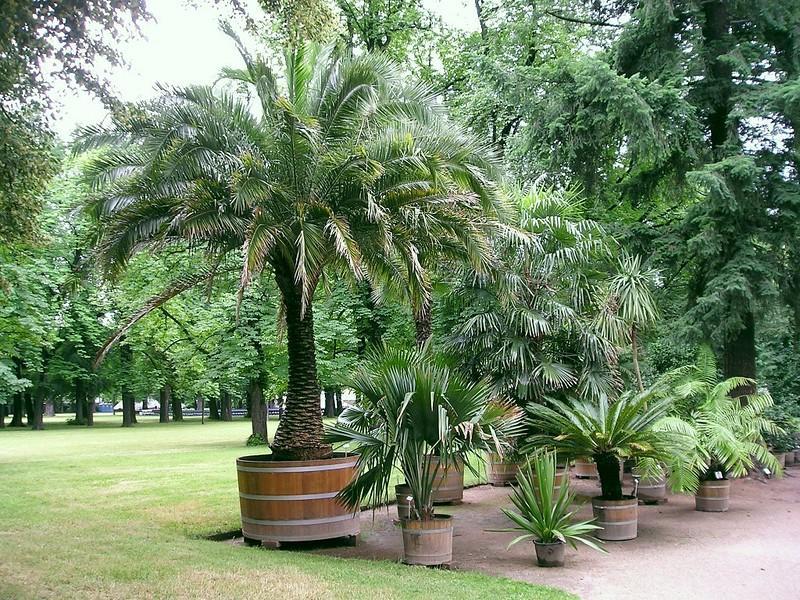
Pygmy Date Palm is a subtropical spreading palm that brings tropical vibes to your interior spaces.
Key Characteristics
| Other Common Names | Dwarf Date Palm |
| USDA Hardiness Zones | 9b to 11 |
| Geographical Origin | Southeast Asia |
| Mature Height | 6-12 ft (1.8-3.6 m) |
| Mature Spread | 6-10 ft (1.8-3 m) |
| Life Span | Up to 50 years |
| Foliage & Floral Features | Pinnate fronds with a dark green color. Tiny yellow flowers followed by edible fruit like a date. |
Description & Identification Guide
The pygmy date palm has a slender stem covered in a brownish-gray bark and topped with a crown of feathery, pinnate leaves. The leaves are dark green, with a glossy sheen and a curved shape.
Pygmy date palm is often used as a decorative plant around pools, patios, and walkways. However, sometimes it is also planted in containers for indoor use. Pruning is sometimes needed to keep growth manageable but is relatively low-maintenance overall.
12. Mediterranean Fan Palm (Chamaerops Humilis)
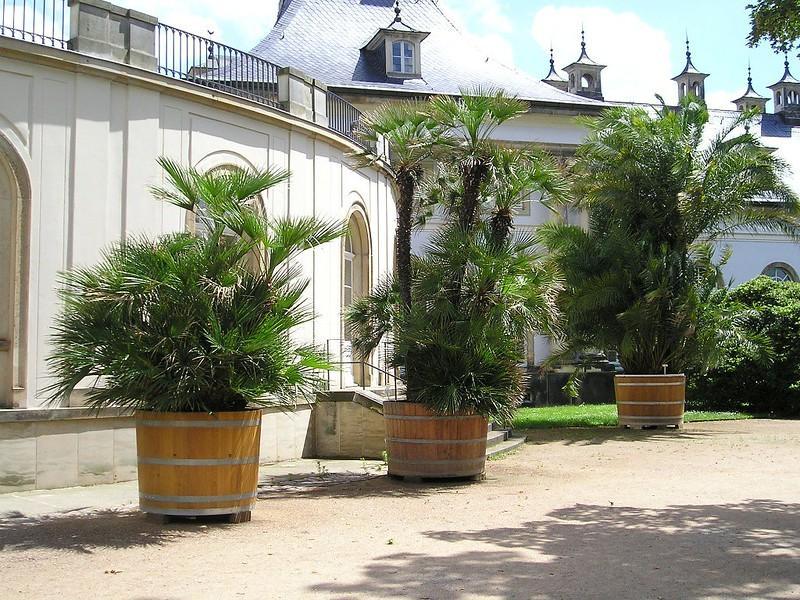
The Mediterranean fan palm is one of the toughest and most durable that you can plant in Florida.
Key Characteristics
| Other Common Names | European Fan Palm, Dwarf Fan Palm |
| USDA Hardiness Zones | 8b to 11 |
| Geographical Origin | Mediterranean region |
| Mature Height | 8-15 ft (2.4-4.6 m) |
| Mature Spread | 6-10 ft (1.8-3 m) |
| Life Span | Up to 100 years |
| Foliage & Floral Features | Palmate fronds with a blue-green color. Tiny yellow flowers followed by black, berry-like fruits. |
Description & Identification Guide
The Mediterranean Fan Palm is a slow-growing, multi-stemmed palm. Its branches are covered with brownish-gray bark and have a crown of fan-shaped bright green leaves that grow in a dense cluster. The leaves are spreading and have an overall waxy texture.
The Mediterranean Fan Palm can tolerate hot and dry weather conditions, making it a popular choice for the Mediterranean and subtropical regions of the country.
13. Arikury Palm (Syagrus Schizophylla)
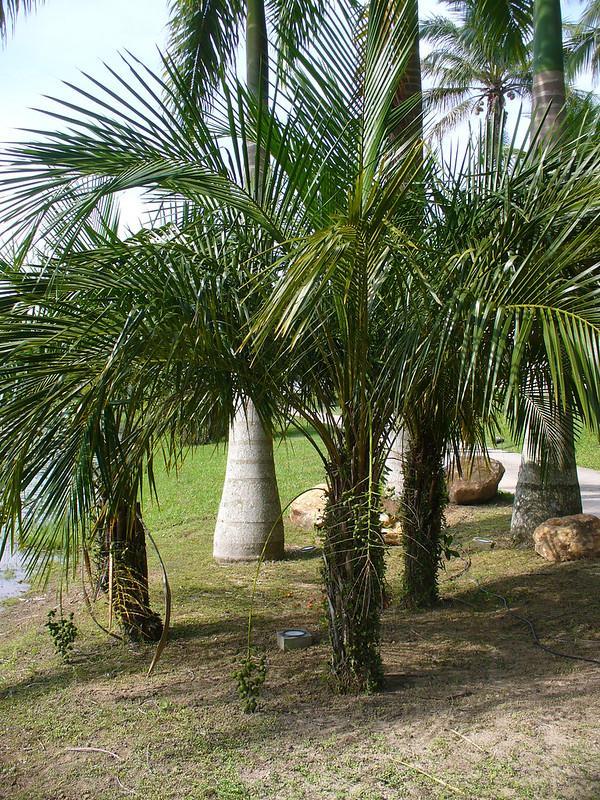
Pretty as a snapshot, the Arikury palm is an excellent small accent palm for compact spaces.
Key Characteristics
| Other Common Names | Arikaree Palm |
| USDA Hardiness Zones | 9b to 11 |
| Geographical Origin | Brazil |
| Mature Height | 20-30 ft (6-9 m) |
| Mature Spread | 8-12 ft (2.4-3.6 m) |
| Life Span | Up to 100 years |
| Foliage & Floral Features | Pinnate fronds with a light green color. Tiny yellow flowers followed coconut-like fruit. |
Description & Identification Guide
Arikury Palm has a slender stem covered in a grayish-brown bark and topped with a crown of feather-like leaves. The leaves are bright green and have a drooping, arching shape that gives the palm a graceful appearance. Another way to identify Arikury Palm is its bark marked with distinctive diamond-shaped leaf scars. Furthermore, it can tolerate a wide range of soil types and adds a touch of tropical elegance to any landscape.
14. Lipstick Palm (Cyrtostachys Renda)
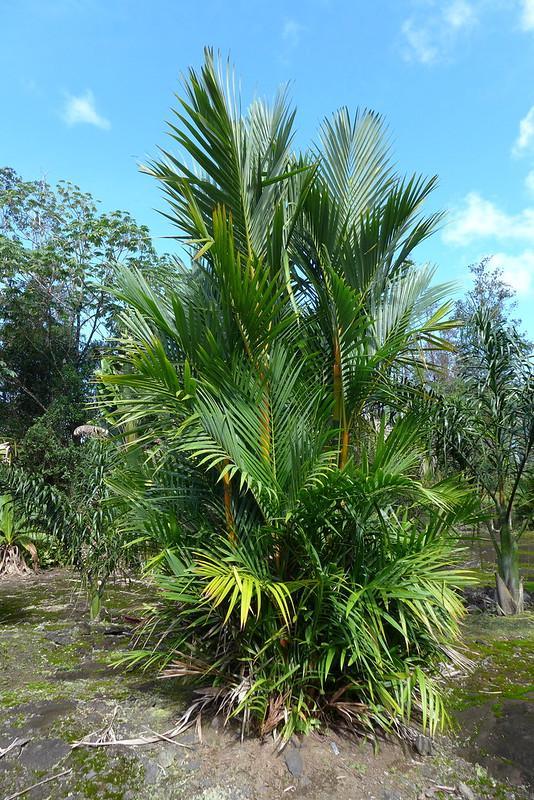
Lipstick Palm is a slow-growing tropical palm known for its brilliant red-colored crown shaft.
Key Characteristics
| Other Common Names | Red Sealing Wax Palm |
| USDA Hardiness Zones | 10 to 11 |
| Geographical Origin | Southeast Asia |
| Mature Height | 20-30 ft (6-9 m) |
| Mature Spread | 8-10 ft (2.4-3 m) |
| Life Span | Up to 20 years |
| Foliage & Floral Features | Feather-like fronds with a bright red crown shaft. Tiny yellow flowers followed by red, berry-like fruits. |
Description & Identification Guide
The Lipstick Palm is a striking and highly prized palm tree due to its vibrant red trunk and ability to add a tropical splash of color to any landscape. It can be easily identified from its slender and bright red-colored stem with a crown of pinnate colorful green leaves with a feathery appearance giving the tree a graceful and delicate look. Lipstick Palm performs best in sunny areas and looks stunning snugged alongside a sun-drenched patio.
RELATED: Shrouded in Mystery: 37 Different Types Of Mystic Trees
15. Fishtail Palm (Caryota Mitis)
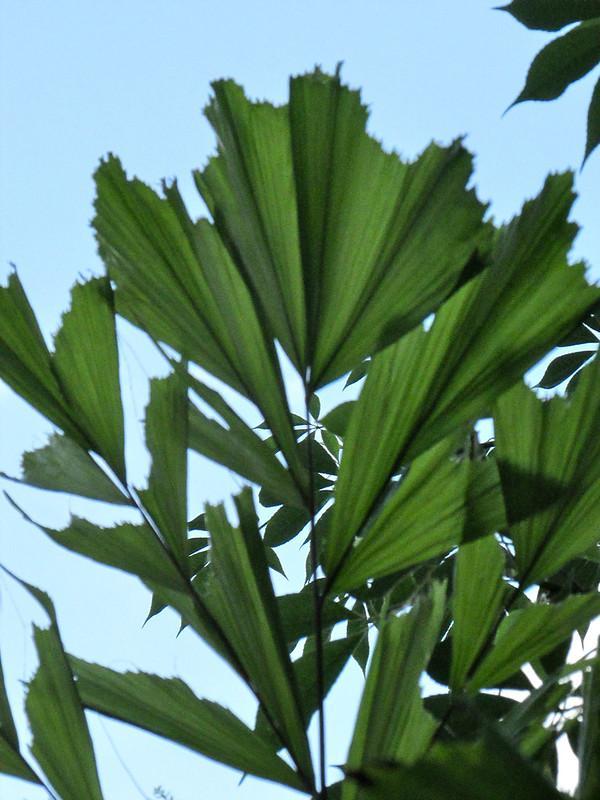
Known for their unusual leaves, fishtail palms make excellent outdoor substitutes for invasive bamboo.
Key Characteristics
| Other Common Names | Clustered Fishtail Palm, Burmese Fishtail Palm |
| USDA Hardiness Zones | 10 to 11 |
| Geographical Origin | Southeast Asia, Indonesia |
| Mature Height | 10-20 ft (3-6 m) |
| Mature Spread | 6-10 ft (1.8-3 m) |
| Life Span | Up to 25 years |
| Foliage & Floral Features | Bi-pinnate fronds resembling a fish’s tail. Tiny white flowers followed by small, brownish-black fruits. |
Description & Identification Guide
The Fishtail palm is named because of its distinctively shaped leaves with individual leaflets that are deeply divided and have a serrated edge. Its stem is covered in a grayish bark, and the plant produces small, discreet flowers that grow in clusters at the base of the leaves.
These eye-catching palms can be grown in large areas like atriums, making excellent large houseplants. However, it needs full sun and doesn’t perform well in the shade.
16. Red Latan Palm Tree (Latania lontaroides)
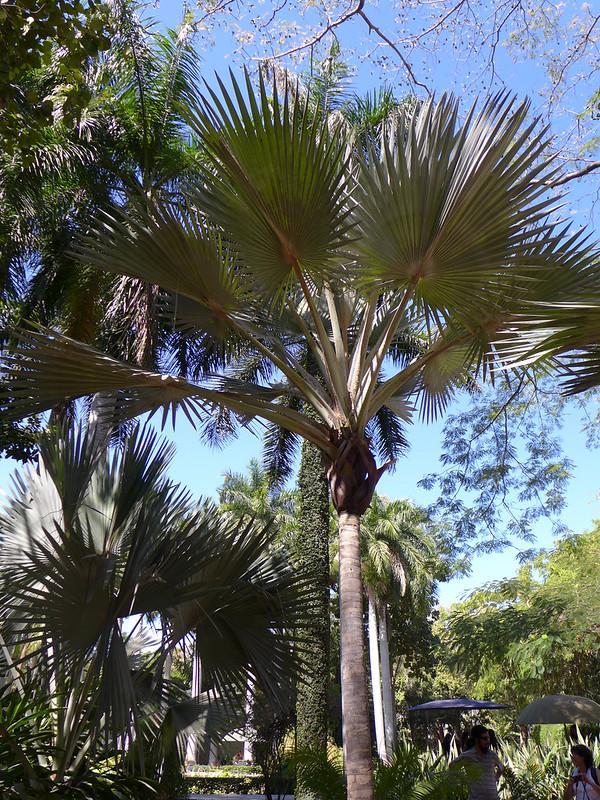
Red Latan Palm Tree is a large fan palm well-known for its stunning reddish-color leaf stems.
Key Characteristics
| Other Common Names | – |
| USDA Hardiness Zones | 10 to 11 |
| Geographical Origin | Mascarene Islands |
| Mature Height | 20-30 ft (6-9 m) |
| Mature Spread | 8-10 ft (2.4-3 m) |
| Life Span | Up to 100 years |
| Foliage & Floral Features | Palmate fronds with a bluish-green color and reddish petioles. Tiny yellow flowers followed by small, black fruits. |
Description & Identification Guide
Red Latan Palm is a popular addition to tropical gardens due to its attractive red stems and green fronds with significant ornamental value. Sadly, however, the plant is classified as endangered by the International Union For Conservation of Nature.
The tree’s crown comprises large, fan-shaped leaves that are deep green and have a glossy, waxy appearance. Latan palm also works well in large containers while young.
17. Bangalow Palm (Archontophoenix cunninghamiana)

Bangalow palms are beautiful plants that can create a tropical look in any living space.
Key Characteristics
| Other Common Names | King Palm, Illawarra Palm |
| USDA Hardiness Zones | 10 to 11 |
| Geographical Origin | Eastern Australia |
| Mature Height | 40-50 ft (12-15 m) |
| Mature Spread | 10-15 ft (3-4.5 m) |
| Life Span | Up to 80 years |
| Foliage & Floral Features | Pinnate fronds with a dark green color. Cream-colored flowers followed by red or purple fruit. |
Description & Identification Guide
Bangalow palms are spectacular and grow naturally in creek beds and gullies. Unlike many other palms, they are cold-tolerant and will handle some degree of frost when fully mature.
Bangalow stems have tall, slender stems covered in a smooth, grayish-brown bark and topped with a crown of feathery fronds. These fronds are arranged symmetrically, giving the Bangalow Palm a distinctive, tropical, and attractive look.
18. Coconut Palm (Cocos Nucifera)
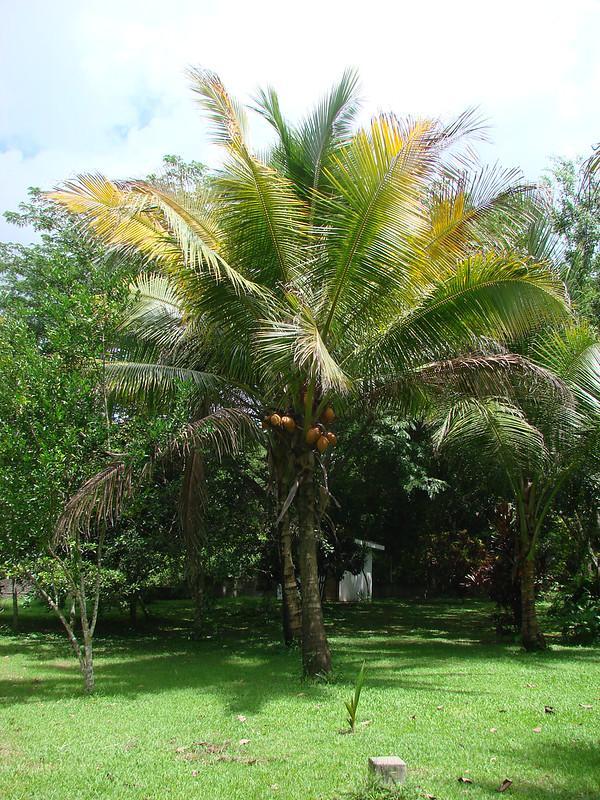
The coconut palm has a slim and smooth trunk and grows naturally along tropical coastlines.
Key Characteristics
| Other Common Names | – |
| USDA Hardiness Zones | 10 to 13 |
| Geographical Origin | Tropical regions worldwide |
| Mature Height | 50-80 ft (15-24 m) |
| Mature Spread | 20-30 ft (6-9 m) |
| Life Span | Up to 100 years |
| Foliage & Floral Features | Pinnate fronds with a light green color.Yellow flowers followed by large, brown, hairy fruits (coconuts). |
Description & Identification Guide
An iconic symbol of the tropics, the coconut palm is ornamental and one of the world’s most economically significant trees. Its stem is covered in a grayish-brown bark marked with distinctive horizontal rings, and its leaves are green fronds arranged symmetrically.
Indoors, these palms are generally short-lived, don’t produce fruit, and stay small. However, outdoors, coconut palms live for decades and reach immense heights.
19. Florida Royal Palm (Roystonea Regia)
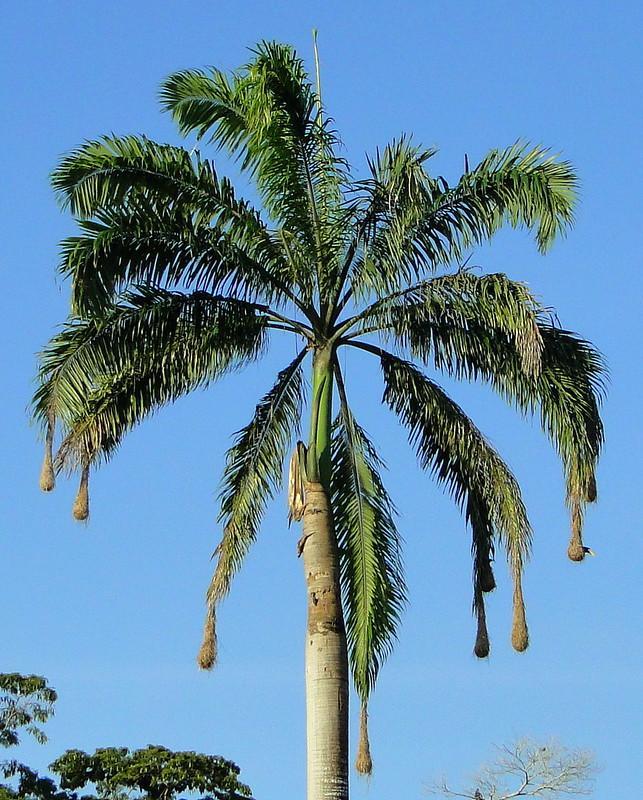
Soaring to 80 feet tall and more, Florida Royal Palm is one of the most sought-after landscape palms.
Key Characteristics
| Other Common Names | Cuban Royal Palm, Royal Palm |
| USDA Hardiness Zones | 10 to 11 |
| Geographical Origin | Cuba, Florida, and parts of Central America |
| Mature Height | 50-70 ft (15-21 m) |
| Mature Spread | 15-25 ft (4.5-7.6 m) |
| Life Span | Up to 100 years |
| Foliage & Floral Features | Pinnate fronds with a bright green color |
Description & Identification Guide
Florida Royal Palm has a smooth, light gray trunk up to 2 ft. in diameter. Its bark is marked with distinctive vertical rows of leaf scars, and it is a popular choice for landscaping in subtropical and tropical regions. The tree’s crown comprises large, feathery fronds, making the Florida Royal Palm distinctive and attractive. Also, these palm trees are considered self-cleaning. Their dying old leaves will cleanly drop off by themselves.
20. Cabbage Palm (Sabal Palmetto)
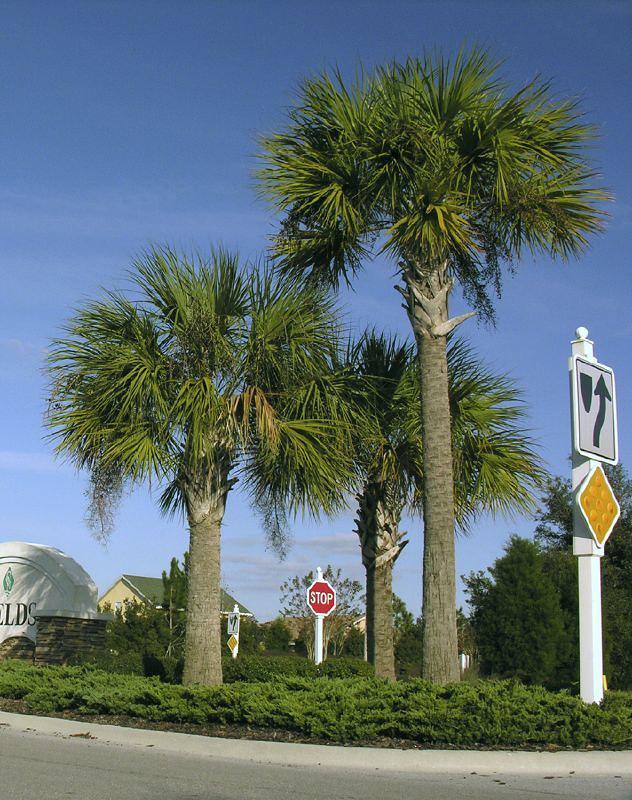
The Cabbage Palm has costapalmate-type leaves, a mix of palmate and pinnate fan-shaped leaves.
Key Characteristics
| Other Common Names | Sabal Palm, Palmetto, Cabbage Palmetto |
| USDA Hardiness Zones | 8 to 11 |
| Geographical Origin | Southeastern United States and Cuba |
| Mature Height | 30-60 ft (9-18 m) |
| Mature Spread | 10-20 ft (3-6 m) |
| Life Span | Up to 500 years |
| Foliage & Floral Features | Palmate fronds with a bluish-green color. Tiny white flowers followed by black fruit. |
Description & Identification Guide
The Cabbage Palm Tree has recently gained immense popularity as it is durable and tolerates various weather and soil conditions. Its stem is covered in a rough, fibrous bark that is grayish-brown, whereas the crown of the tree is made of bright green colored leaves, which are arranged in a circular pattern at the top of the stem. If you like them, you can grow them as street trees or in groups, and they will give the entire area a tropical look.
21. Canary Island Date Palm (Phoenix Canariensis)
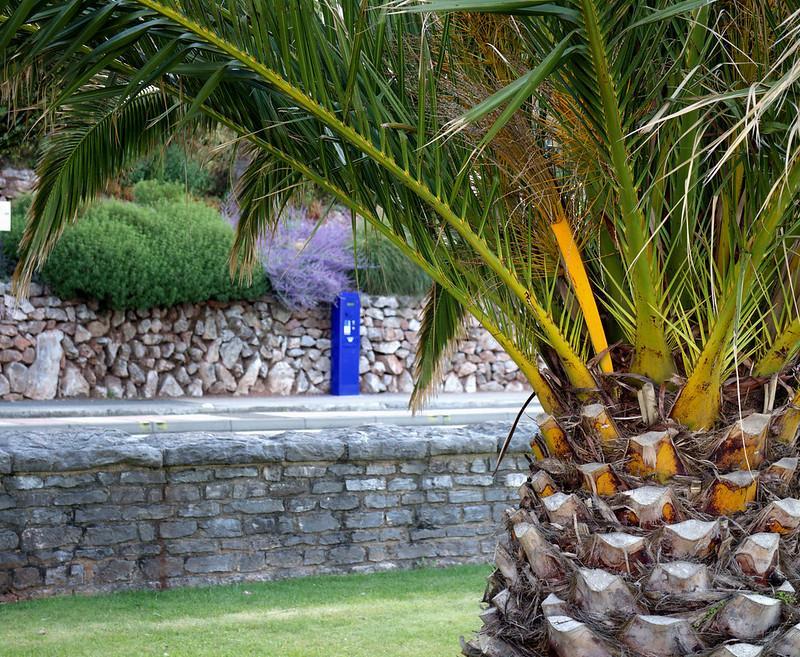
Canary Island Date Palm is a majestic palm tree with a stout trunk topped and a round crown.
Key Characteristics
| Other Common Names | Pineapple Palm, Canary Palm |
| USDA Hardiness Zones | 9 to 11 |
| Geographical Origin | Canary Islands |
| Mature Height | 50-60 ft (15-18 m) |
| Mature Spread | 20-25 ft (6-7.6 m) |
| Life Span | Up to 200 years |
| Foliage & Floral Features | Pinnate fronds with a bluish-green color. Tiny yellow flowers followed by brown, oval fruits (dates). |
Description & Identification Guide
The Canary Island Date Palm has a tall, thick trunk covered in a rough, textured bark that is gray-brown and marked with distinctive diamond-shaped patterns. At the same time, the tree’s crown comprises large, feathery fronds arranged symmetrically. However, if you decide to plant this on your property, please remember that this tree is not of the low-maintenance school. So, ensure you understand its care needs entirely.
22. Chinese Fan Palm (Livistona Chinensis)
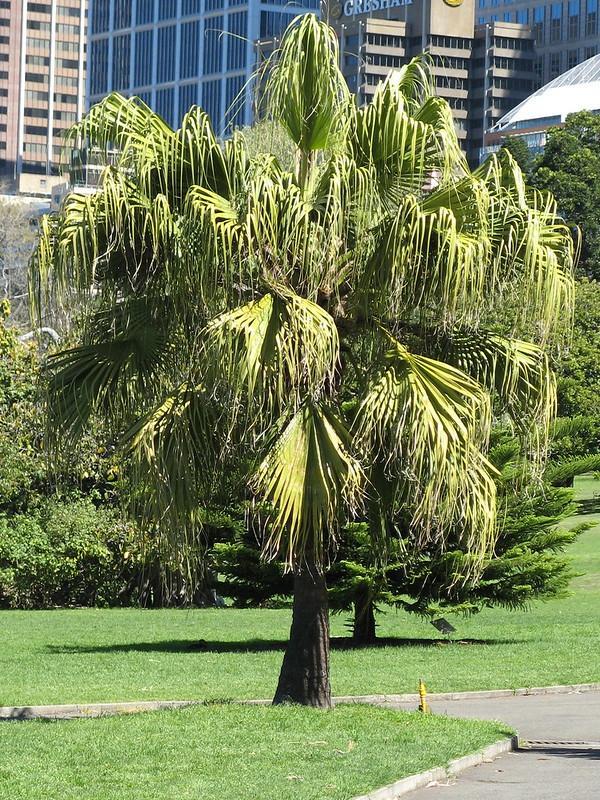
Chinese fan palms are relatively famous as indoor plants despite their outdoorsy nature.
Key Characteristics
| Other Common Names | Fountain Palm, Chinese Fountain Palm |
| USDA Hardiness Zones | 8 to 11 |
| Geographical Origin | Southern Japan, Taiwan, and China |
| Mature Height | 30-50 ft (9-15 m) |
| Mature Spread | 10-15 ft (3-4.5 m) |
| Life Span | Up to 100 years |
| Foliage & Floral Features | Palmate fronds with a light green color |
Description & Identification Guide
The Chinese Fan Palm has a tall, slender trunk covered in a smooth, gray-brown bark marked with distinctive rings. The tree’s crown comprises large, fan-shaped bright green fronds arranged symmetrically. Overall, the Chinese Fan Palm is a visually stunning plant that adds a touch of elegance to any landscape. However, be careful when going near it. Its petioles are armed with sharp spines that can puncture skin quickly.
23. Queen Palm (Syagrus Romanzoffiana)
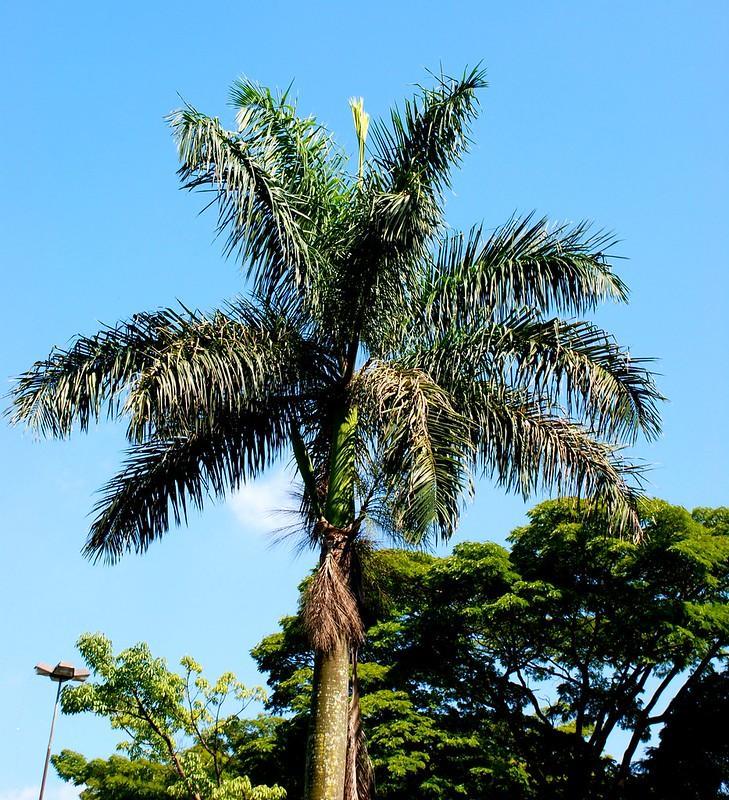
Native to China, this palm sports a broad crown with elegant leaf stalks supporting rounded leaves.
Key Characteristics
| Other Common Names | Cocos Palm, Arecastrum romanzoffianum |
| USDA Hardiness Zones | 9 to 11 |
| Geographical Origin | South America |
| Mature Height | 50-60 ft (15-18 m) |
| Mature Spread | 15-20 ft (4.5-6 m) |
| Life Span | Up to 50 years |
| Foliage & Floral Features | Pinnate fronds with a light green color. Large, creamy white plumes of flowers |
Description & Identification Guide
The queen palm is a popular feather-leaved palm with graceful arching leaves. It has a smooth gray trunk. And, like ike many tall palms, the trunk is branchless, straight, and crowned with a canopy of palm leaves. It is often planted as a solitary tree. However, depending on the landscaping requirements, it can also be effective when planted in groups.
24. Foxtail Palm (Wodyetia Bifurcata)
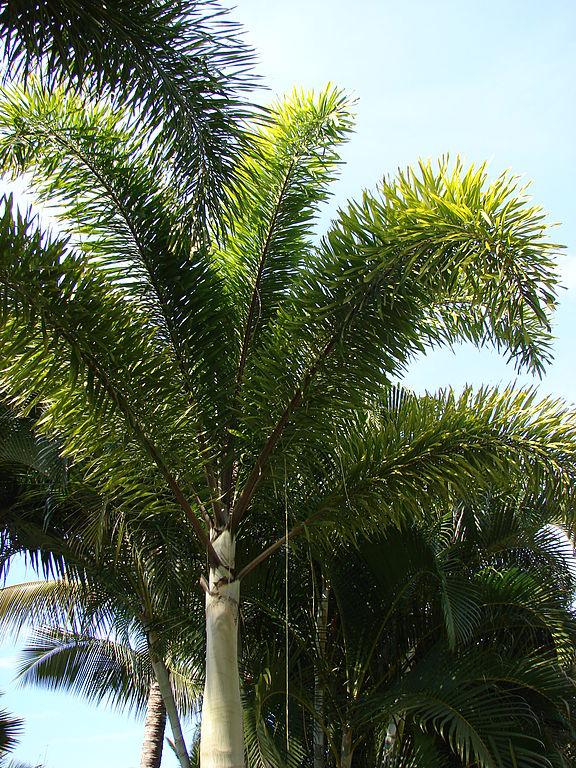
The Foxtail palm is immensely famous for its perfect proportions and rounded fronds resembling a fox’s tail.
Key Characteristics
| Other Common Names | Wodyetia Palm, Foxy Palm |
| USDA Hardiness Zones | 10 to 11 |
| Geographical Origin | Northern Australia |
| Mature Height | 30-40 ft (9-12 m) |
| Mature Spread | 15-20 ft (4.5-6 m) |
| Life Span | Up to 50 years |
| Foliage & Floral Features | Pinnate fronds with a dark green color and a unique “foxtail” appearance. Small white flowers followed by small red fruit |
Description & Identification Guide
The foxtail palm is an easy-growing tree for frost-free regions. It comes in single-trunk and multi-trunk varieties and can be identified by its massive fronds growing up to 12 feet long. The tree also produces clusters of colorful red fruits that add to its ornamental appeal.
The Foxtail palm has gained popularity as it will tolerate various soil conditions and has a deep root system that helps it to withstand high winds and tolerate drought.
25. Buccaneer Palm (Pseudophoenix Sargentii)
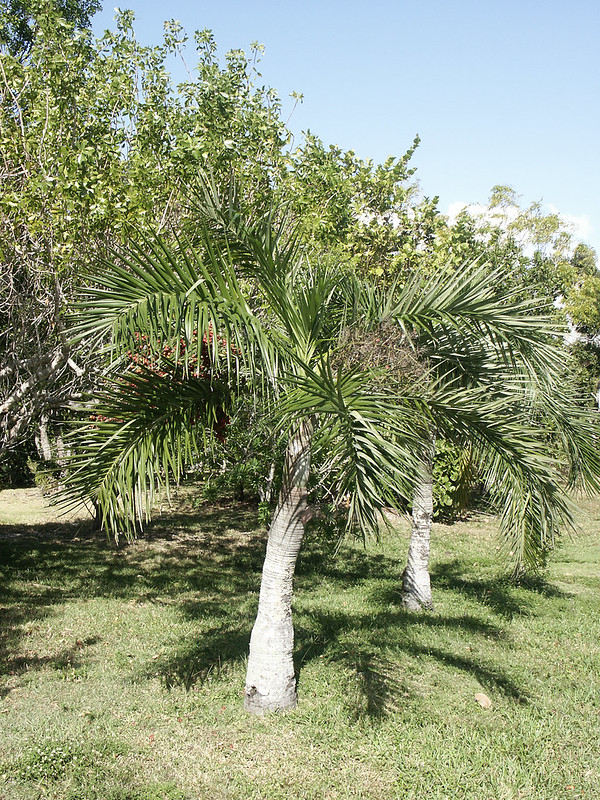
The Buccaneer Palm Tree is a handsome non-spiny solitary palm and, indeed, a collector’s palm.
Key Characteristics
| Other Common Names | Sargent’s Cherry Palm, Cherry Palm, Palmetto |
| USDA Hardiness Zones | 10 to 11 |
| Geographical Origin | Florida, the Bahamas, and the Caribbean |
| Mature Height | 15-20 ft (4.5-6 m) |
| Mature Spread | 6-10 ft (1.8-3 m) |
| Life Span | Up to 80 years |
| Foliage & Floral Features | Pinnate fronds with a bluish-gray color |
Description & Identification Guide
The buccaneer palm is notable for extremes, i.e., drought tolerance, salt tolerance, and heat. All of this makes it a good choice for somewhat sheltered coastal settings. Aside from its hardy nature, the plant has smooth old leaf bases that give this palm an elegant tropical look. Buccaneer palm also has a self-cleaning trunk and is very easy to grow.
26. Alexander Palm Tree (Ptychosperma Elegans)
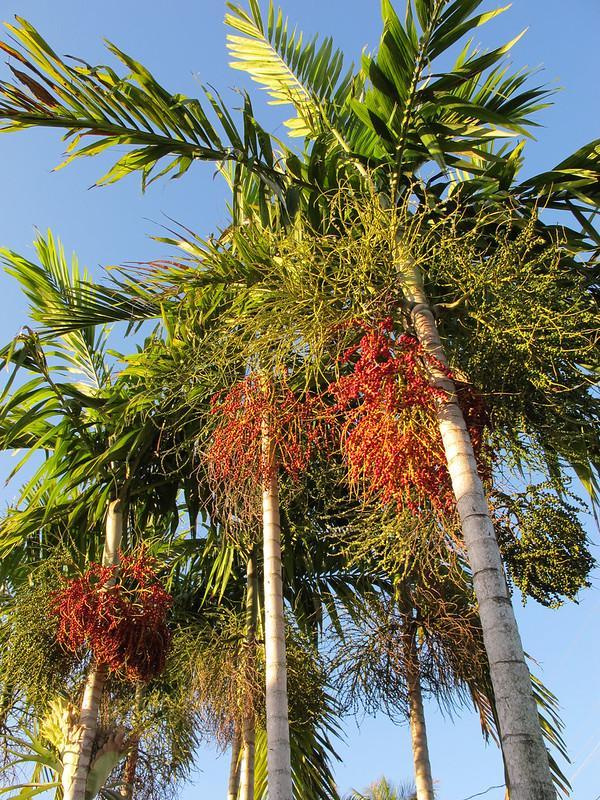
Alexander’s palm is famous in zones 10B-11 and makes a stately accent within any landscape.
Key Characteristics
| Other Common Names | Solitaire Palm, Elegant Palm |
| USDA Hardiness Zones | 10 to 11 |
| Geographical Origin | Australia, Papua New Guinea, and the Solomon Islands |
| Mature Height | 30-40 ft (9-12 m) |
| Mature Spread | 10-15 ft (3-4.5 m) |
| Life Span | Up to 80 years |
| Foliage & Floral Features | Pinnate fronds with a glossy, dark green color |
Description & Identification Guide
As a native of Australia, Alexander Palm enjoys narrow spaces and presents well due to its slender trunk and smaller canopy. Its trunk is gray, with leaf scars marking the entire length of the trunk. Furthermore, it has a classic “palm” look that makes it perfect for gardeners wanting to establish a tropical garden. Also, its foliage features fronds with a silver underside that catches the sunlight, especially when the sun is low.
27. Dwarf Palmetto (Sabal Minor)
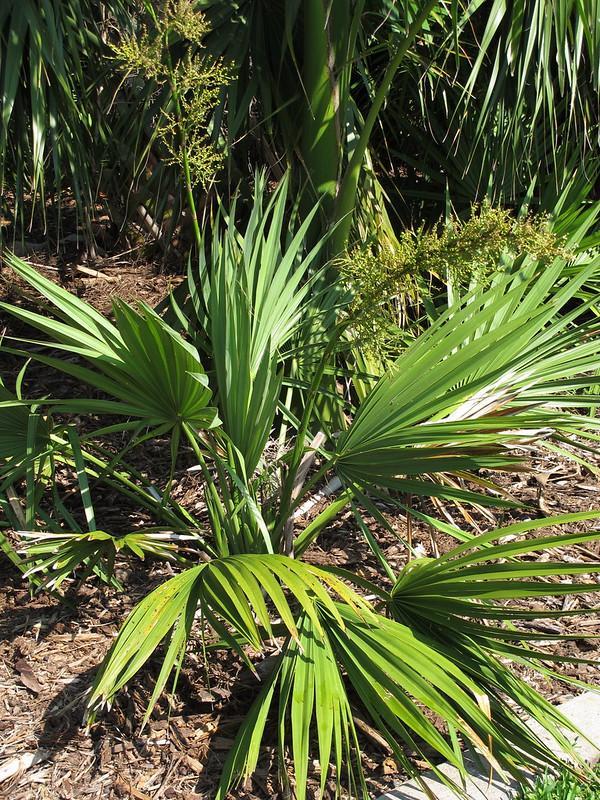
One of the hardiest palms, Sabal minor, is a small evergreen palm that is usually trunkless.
Key Characteristics
| Other Common Names | Blue-stem Palmetto, Bush Palmetto, Scrub Palm |
| USDA Hardiness Zones | 7 to 11 |
| Geographical Origin | Southeastern United States |
| Mature Height | 3-6 ft (0.9-1.8 m) |
| Mature Spread | 6-10 ft (1.8-3 m) |
| Life Span | Up to 300 years |
| Foliage & Floral Features | Fan-shaped leaves with a bluish-green color. Small, white flowers followed by black fruit |
Description & Identification Guide
Dwarf palmetto palm has a short fat trunk, smooth branches, and large fan-shaped leaves. As evident by its name suggests, it is a small palm tree which makes it ideal for planting alongside narrow walkways and driveways. These small palms have the advantage of being attractive and easy to care for, and they can act as focal points in beds and gardens, or you can grow them as understory palms for taller trees in small groups.
The Bottom Line
Florida has the perfect conditions for growing palm trees. So, if you live in Florida and enjoy the tropical look of palm trees, this listicle will help you get started. However, before you decide to buy any of these palm trees, please ensure you understand your needs and all of the care requirements of the palm tree under consideration.
Frequently Asked Questions (FAQs)
What is Florida’s most common palm tree?
Some of the most common native Florida palms are silver palms, royal palms, needle palms, and cabbage palms. However, you might also see many other imported varieties as well.
What are the most expensive Florida palm trees?
The Coco De Mer Palm Tree is the most costly palm tree in Florida; many people have not even heard of it. It can cost anywhere from $300 to $9000 and is rare.
What is the fastest-growing palm in Florida?
The Carpentaria palm is arguably the fastest-growing palm tree in Florida. It can add a whopping six to eight feet of height per year if soil and weather conditions are right.
What city is known for palm trees?
Los Angeles is a city known for palm trees, where these plants flourished alongside the expansive freeways. Its beaches and roads are lined with multiple varieties of palm trees, and as many as 40,000 palms were planted to beautify the city before the 1932 Olympics.
Why do palm trees only grow in Florida?
Palm trees do not only grow in Florida. However, it is where most palm trees are found in the US. It is because Florida has the perfect environment for palm trees.
Sources For Further Reading
Communications, I. (2023). Florida Palms – UF/IFAS Extension. Retrieved 17 March 2023, from https://sfyl.ifas.ufl.edu/lawn-and-garden/florida-palms/
The University of Florida scientists have developed a way to detect disease-killing palm trees. (2022). Retrieved 17 March 2023, from https://www.fox13news.com/news/university-of-florida-scientists-develop-way-to-detect-disease-killing-palm-trees
Florida is ditching palm trees to fight the climate crisis. (2021). Retrieved 17 March 2023, from https://abc7chicago.com/florida-palm-trees-climate-change-miami-beach/11163264/
What are your favorite top palm trees in Florida? Comment below. Also, check out our other articles:
Top 15 Privacy Trees For Your Lovely Backyard | A Comprehensive Guide
Watering A Pine Tree: How To Do It Right! | A Comprehensive Guide
How To Differentiate Between Coconut & Palm Trees | The Ultimate Guide






